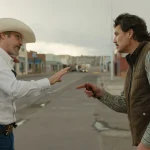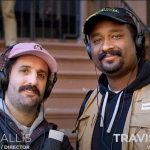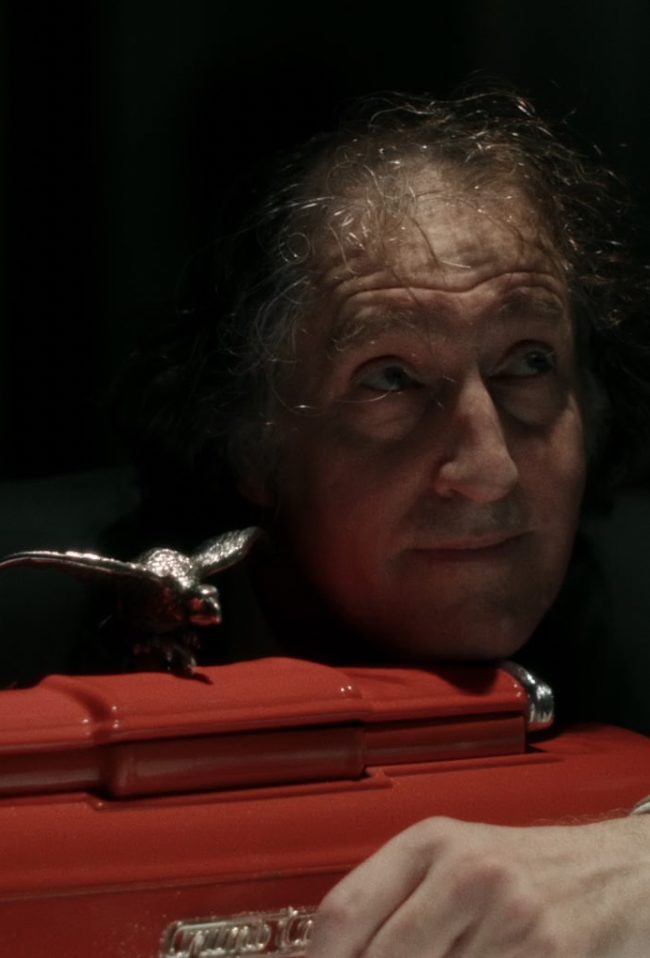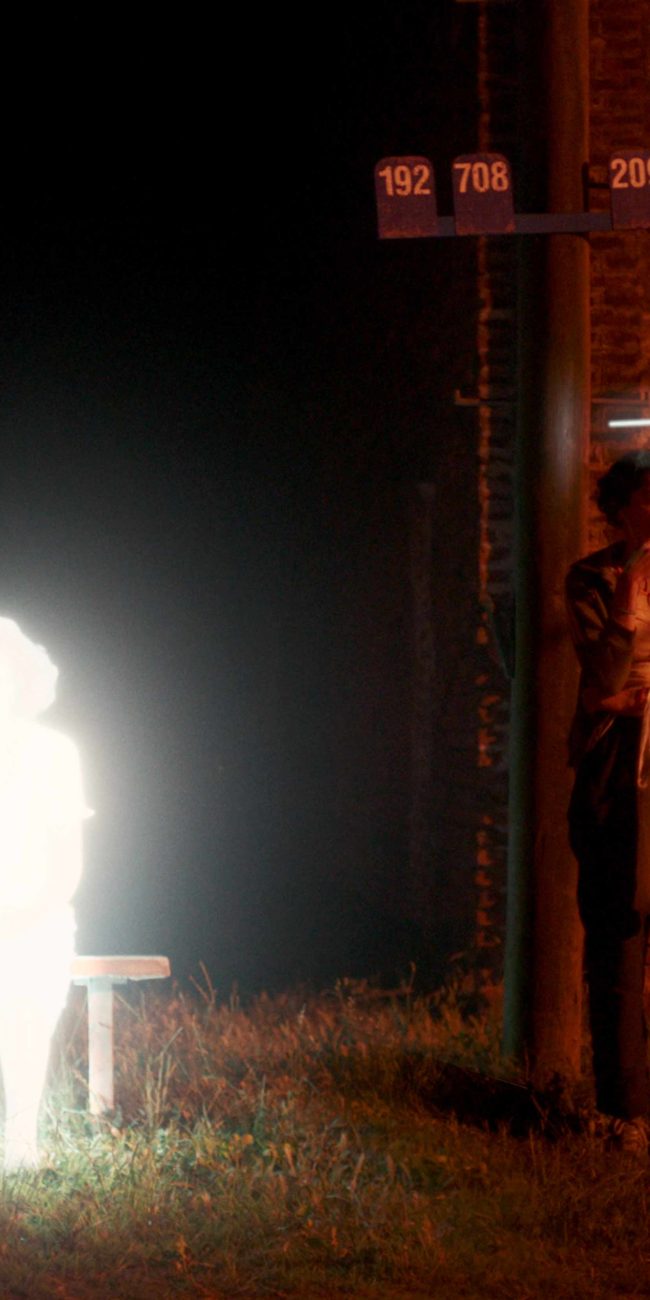A Conversation with Ted Geoghegan (BROOKLYN 45)
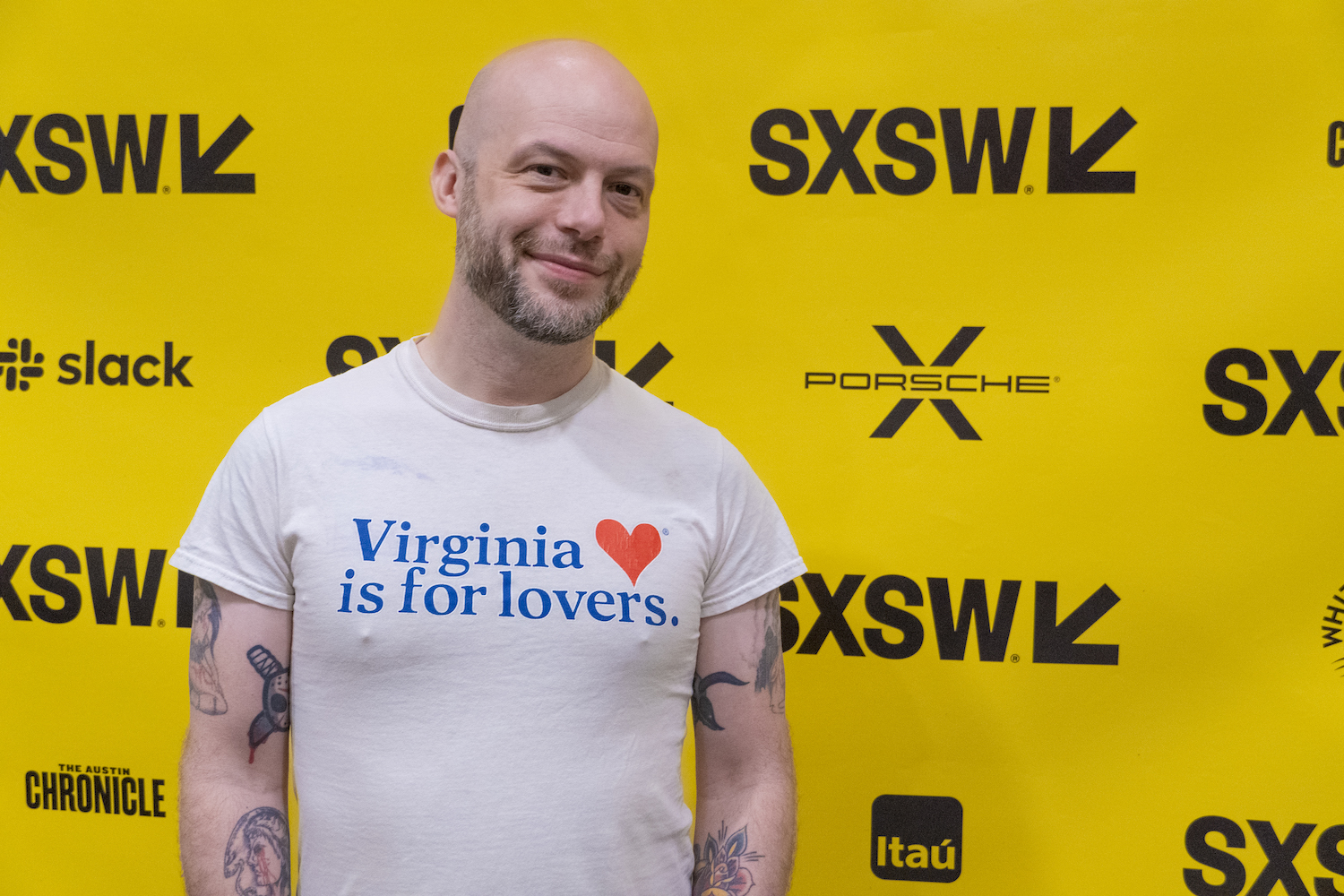
Director Ted Geoghegan (We Are Still Here) just premiered his latest film, Brooklyn 45, at SXSW 2023 (where I reviewed it). It follows a group of five people who gather in the direct aftermath of World War II’s conclusion and find they can’t let go of the ghosts of atrocities past. Starring a terrific ensemble cast of Ezra Buzzington (Mohawk), Larry Fessenden (Jakob’s Wife), Jeremy Holm (Don’t Look Back), Kristina Klebe (Sinister Seduction), Ron E. Rains, (When Icarus Fell), and Anne Ramsay (The Taking of Deborah Logan), the movie combines real-world and supernatural horror, with some fine, gory practical effects thrown in. I spoke with Geoghegan at the festival, and here is a transcription of that conversation, edited for length and clarity.
Hammer to Nail: If you were to pitch this film to somebody, how would you describe it?
Ted Geoghegan: I would describe it as: five world-weary veterans getting together for cocktails and having it quickly devolve into a séance, where they are haunted not only by the metaphoric ghosts of their past, but the literal ghosts of their past.
HtN: All right.
TG: That’s my best.
HtN: I’ll buy that for a dollar.
TG: Yep.
HtN: So have you always been interested in this combination of real-world horror and the tropes of the horror genre?
TG: Yeah, very much so. I mean, I’m emblazoned in horror tattoos. I’ve always loved horror, and not just as escapist entertainment. I grew up in rural Montana and it was very boring out there. So my first love was sci-fi and fantasy, and then I just kind of fell into horror and started loving it. It just became my passion as I grew up. But I always loved the fact that in genre entertainment, horror in particular, you can say so much about the world without saying it.
My best example, and I think it’s a lot of people’s go-to, is George A. Romero’s Dead series, and not just his Dead series, but so many of his other films. I mean, they’re about racial inequity, they’re about neighbors being afraid of neighbors during the summer of love. It’s about rampant consumerism. It’s about the fear of the military. But it’s a zombie movie, so it’s more accessible.
And I always thought that was so cool because I don’t want to watch a movie about rampant consumerism. But you tell me there’s a movie about zombies in a shopping mall, and it’s going to completely skewer the concepts of consumerism and shopping malls destroying mom-and-pop shops, sign me up. That was a big impetus behind all three of the films I’ve directed. I’m very political. I want to be able to talk about things that I care about. And sometimes the movies themselves have an agenda. Sometimes they don’t.
HtN: Beyond Romero, do you have any other sort of horror touchstones? I realize I could just look at your tattoos …
TG: God, I love classic horror. I love Universal Monsters, like the classics. My favorite is The Mummy. I grew up on ‘80s slashers. I love ‘70s and 80s slashers. I think they’re unjustly maligned in a lot of ways. I think a lot of them had a lot to say and just get written off as silly. And a lot of them are silly, but they still have something to say. And I think there’s greatness in that. And then some of them are silly and they don’t have shit to say, but they’re just fun.
HtN: Why set this film in this particular moment? What came first, the idea of wanting to have friends around a table, conducting a séance where they explore trauma, or the time period, or both? How did that work?
TG: So when I made We Are Still Here in 2015, there’s a scene where two middle-aged men have a séance, played by actors Larry Fessenden and Andrew Sensenig. And when that film came out, a lot of people were like, “Oh, I love that séance scene.” And my joke answer to them was always like, “Oh, if you love it that much, my next movie’s just going to be one long séance.” And people got a chuckle out of it. But they kind of planted that seed of what it would take to do that, like a real-time séance, a movie set over 85 minutes that’s just about people holding hands at a table and spooky shit happens. And so that came first.
I then started thinking about what time period I would like to set it in. If I’m directing something, I’ll do everything in my power to not set it in the present. I don’t like the present, but sadly, most of the past is still happening, so there’s not that much escapism. So I started looking at time periods that I was interested in. You can look at the spook shows and stuff that were happening around the turn of the century, this huge rise in spiritualism and how it just became rampant. And I thought, “Well, that could be really interesting to set it then, right around the turn of the century.” And then I started thinking about the specter of World War I coming. And the more I thought about it, I was like, “I feel disassociated from that time.” Whereas World War II, my grandfather served in World War II, my grandfather and namesake. There was a Theodore Geoghegan out there on the front lines.
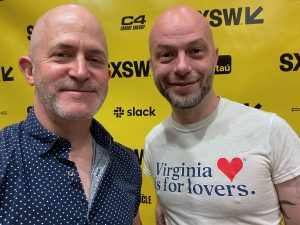
Our Chris Reed and filmmaker Ted Geoghegan
And I thought, well, that’s something that I’m starting to feel is a very powerful time. I thought, “So these people are having a séance during World War II.” And then I started thinking about people who are unable to let go when a war is over. And then I started thinking, “Well, God, what about right after World War II?” And I started thinking about post-war America, but then I was like, “Oh, post-war America is the sailor kissing the girl in Times Square. And everybody comes home and they move to suburbia and they get a car and they have 2.5 children and all that sort of stuff.” And I was like, “That’s not that exciting.” But then I started reading up on it.
The year and a half after the end of the war was nightmarish. And it doesn’t get talked about a lot. Obviously, the suburbia and the post-war boom that occurred, that was a thing. But in the months and the years right after the war, suicides were at an all-time high. People were absolutely broken. The country was in shambles in 1945 and 1946. We look back on it with rose-colored glasses, like Hitler’s dead, everything’s great, but it wasn’t. And I just thought, “Well, that’s a neat time period to set this in, that I’ve never seen a film, genre or not, set in that window of when things were really bad and nobody was talking about it.”
HtN: Sure. Although as I sat here waiting to talk to you, the previous interviewer did bring up The Best Years of Our Lives, which is probably the closest that we could come to delving into that kind of malaise right afterwards. I love that film.
TG: Yeah. Absolutely.
HtN: So you’ve obviously worked with Larry Fessenden before and he did that séance scene, so I get why he’s in the film. For the rest of the cast, how did you go about finding them? Especially that late arrival to the party…
TG: The cocktail party’s unexpected guest.
HtN: And it was unexpected in a way because she was also so good. So please talk about the casting.
TG: Absolutely. So Jeremy Holm, who plays Archie, I had seen in Jenn Wexler’s The Ranger, which had played SXSW a while back. And I’m friends with Jenn. And Jenn had told me he was such a joy to work with. And I thought, well, he’s a great performer and he’s nice to work with? Yes! And Jeremy jumped at the chance. He was super excited and just put his whole heart into it. And Archie is such a complex character, arguably the most complex character in the whole film. And Jeremy, I mean, he dug in deep. And we had constant daily conversations about this guy and where he’s from and what he’s done. And yeah, he’s just incredible.
Anne Ramsey, who plays Marla, I first saw in A League of Their Own, and I grew up with her on television, like Mad About You and The L Word and stuff like that. And I had interviewed a few actors to play Marla on Zoom calls during the height of the pandemic. And I got on a call with Anne, and minutes into the call, we were both teary-eyed. We both just vibed so well. And I hung up the Zoom call and I ran to my wife. And I was like, “We found Marla. I hope that she’s going to be available to do this because this is her, for sure.”
Kristina Klebe plays Hildy. I’ve been friends with Kristina for almost 20 years. She was one of the first people I met when I moved to New York. And I liked her in Rob Zombie’s Halloween and I loved her in Proxy. She gave an amazing performance there. And when the script was written, and there was a German-American woman, and Kristina herself is German-American, she was like, “If you hire anyone else to do this, I’m going to kill you.” (laughs) And I was like, “No, no.” She still auditioned and everything; she went through the process. And her audition was incredible. And I mean, again, she’s phenomenal in the movie. She gives a really amazing performance.
HtN: She does. I agree.
TG: Ezra Buzzington, who plays Paul, he was…
HtN: Who, by the way, has the most amazing ears.
TG: He does have beautiful ears. (laughs)
HtN: You cast him, I’m assuming, for the ears.
TG: (laughs) So, I’d seen Ezra in a couple films in the past, and he plays the main bad guy in Mohawk, my previous film. He’s the central antagonist in that, who’s also just a rampantly, blindly patriotic military official. And he gave such a powerhouse performance in Mohawk that I wanted to work with him again. And he fit the role really well. He’s such a beautiful, expressive character actor. I love working with character actors.
HtN: Can he do a British accent? Because he would be great in a live-action version of Wallace and Gromit, as Wallace.
TG: (laughs) I can see that. Yes. He’d be a good Wallace. So, we talked about Larry. Oh, and Ron, Ronnie Rains, who plays Bob. Ron’s a local Chicago actor. Believe it or not, though I’m now a New Yorker and the movie’s called “Brooklyn 45,” we actually shot it just outside of Chicago.
HtN: Blasphemy!
TG: I know, I know! And I would’ve loved, loved, loved to have shot in New York. It’s just that the Illinois state tax credits were so phenomenal that there was no question about it. When we saw how good the tax credits were, we were like, “We get to make this movie for so much more if we do it in Chicago.”
HtN: Right.
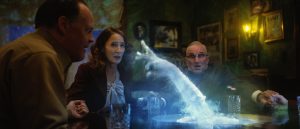
TG: But Ron’s a very popular stage actor in Chicago. He’s currently playing Da in Once on stage there. And I had fallen in love with him from these Onion videos, where he plays their chief film critic named Peter Rosenthal. He’s a fictional film critic, where he just eviscerates movies. And I had loved these videos for years. And when I saw he was available and we were in Chicago, we dialed him up. And he’s amazing. And interestingly enough, Bob, in the film, is the only character who isn’t a veteran. But in real life, Ron is the only one of the bunch who is a veteran.
HtN: That’s great!
TG: Yeah.
HtN: So my final question is about the amazing practical effects, particularly in the moment when a character, whose name I won’t say here, has their face transform rather dramatically. Who did you have working with you on that, because it’s really great. And it got a good audience laugh at the screening last night, too, which is great in a horror film.
TG: Yeah, the movie is so heavy, but there are moments of levity throughout. Obviously, I never want anyone to laugh at the movie, but to laugh with the movie. Because the humanity in the movie is what’s so funny. These moments where somebody says something off color, somebody says something awkward that should get a giggle.
And during one particularly violent sequence, we went that hard because we wanted people to spit out their cola in the theater. It’s a big, bombastic moment. So we used a special-effects artist named Brian Zurek, who’s also based out of Chicago. Really amazing guy. I had never worked with him before, but not only did he create that incredibly gruesome moment, he also created the body that lies on the table for a large portion of the film. It’s a mixture of the performer and the dummy body.
HtN: You didn’t make the actor lie there the entire time? (laughs)
TG: (laughs) No, we did not make that performer lie down for the entire film. And he also created the ghost, Susan Hockstatter, as well. And most of Susan, between the arm sequence and the full ghost sequence, is practical. Even though it’s translucent, it uses a lot of old tricks, like in Ghostbusters, like a glass-plate trick, where you can essentially just put both images over each other and get something that looks ghostly and strange.
HtN: Nice.
TG: Literally, there was a hole cut in the table, and the performer actually had their arm sticking out of the table doing all that. That wasn’t superimposed into that shot. I’m a big fan of practical effects. I try to use them as often as possible. And so we went really hard on how much of this we could do practically. There are still some beautiful VFX enhancements, though. We had a wonderful team handling the CGI stuff, but it was really to accentuate the practical effects rather than replace them.
HtN: Well, it works. Thank you so much for talking to me!
TG: Hey, you got it. Thank you!
– Christopher Llewellyn Reed (@ChrisReedFilm)
2023 SXSW Film Festival; Ted Geoghegan; Brooklyn 45 movie review

